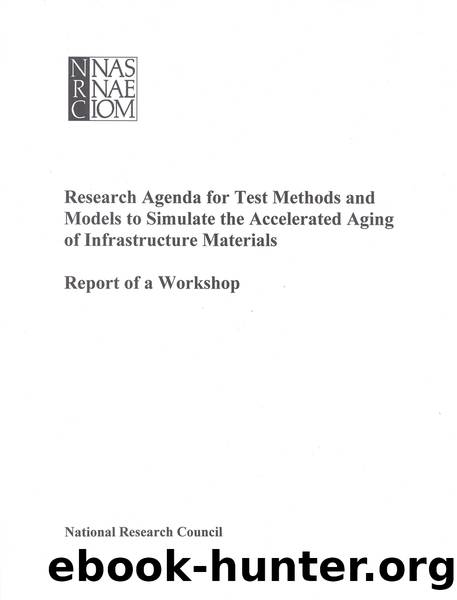Research Agenda for Test Methods and Models to Simulate the Accelerated Aging of Infrastructure Materials: Report of a Workshop by Board on Infrastructure & the Constructed Environment

Author:Board on Infrastructure & the Constructed Environment
Language: eng
Format: epub
Tags: Engineering and Technology : Materials
Publisher: NATIONAL ACADEMY PRESS
Published: 1999-07-06T00:00:00+00:00
The defining conditions for a good structure, Hanson said, are adequate strength, acceptable serviceability, and long-term durability. Mechanical response factors, (i.e. load resistance, stability, fatigue resistance, and fracture resistance) must be addressed to ensure structural integrity.
According to Professor Hanson, the mechanisms of deterioration of the primary construction materials (i.e., concrete, steel, masonry, and timber) are quite well known, at least at the level required of an engineer. Concrete materials, as well as masonry materials, may be subject to scaling due to freezing and thawing, chemical attack, alkali-silica reaction, and corrosion of embedded reinforcements. The deterioration of structural steels is mainly due to corrosion, and the deterioration of timber is due mainly to decay. The rate of deterioration (i.e., durability) is greatly affected by environmental factors, as well as the details of construction. However, our understanding of these mechanisms is currently not sufficient to enable us to make quantitative life predictions. Additional research to enhance understanding of the basic mechanisms is critical to improving the durability of materials and structures.
Professor Hanson emphasized however, that reviews of many infrastructure failures have shown that very few occurred because of deterioration, except when the structure or system had an underlying design or construction defect. Some forms of deterioration seem to slow down or even stop after a period of time. Thus, the deterioration of a material or structure does not necessarily affect safety (See, for example, NRC, 1997 and Levy and Salvadori, 1992). Proper maintenance can prolong the life of materials by slowing their rate of deterioration.
Professor Hanson concluded his presentation by stating that, although the development of a concrete that does not shrink or creep or a steel that does not corrode would be of great benefit to the construction industry, the likelihood of such a material being developed is considered to be very small. Of course, advancements have been, and continue to be, made, but accurate tests for assessing the effects of environmental conditions on their lifetimes will require a much better fundamental understanding of the damage process before they can test results could be used for making life predictions. The adoption of these materials will also depend on their economic advantage in a highly competitive market. Thus, Hanson believes that the lifetimes of structures are more likely to be extended by improvements in the quality of construction, than the use of new materials.
Download
This site does not store any files on its server. We only index and link to content provided by other sites. Please contact the content providers to delete copyright contents if any and email us, we'll remove relevant links or contents immediately.
| Automotive | Engineering |
| Transportation |
Whiskies Galore by Ian Buxton(41710)
Introduction to Aircraft Design (Cambridge Aerospace Series) by John P. Fielding(33011)
Small Unmanned Fixed-wing Aircraft Design by Andrew J. Keane Andras Sobester James P. Scanlan & András Sóbester & James P. Scanlan(32678)
Craft Beer for the Homebrewer by Michael Agnew(18072)
Turbulence by E. J. Noyes(7887)
The Complete Stick Figure Physics Tutorials by Allen Sarah(7257)
Kaplan MCAT General Chemistry Review by Kaplan(6811)
The Thirst by Nesbo Jo(6748)
Bad Blood by John Carreyrou(6467)
Modelling of Convective Heat and Mass Transfer in Rotating Flows by Igor V. Shevchuk(6348)
Learning SQL by Alan Beaulieu(6152)
Weapons of Math Destruction by Cathy O'Neil(6074)
Man-made Catastrophes and Risk Information Concealment by Dmitry Chernov & Didier Sornette(5865)
Digital Minimalism by Cal Newport;(5576)
Life 3.0: Being Human in the Age of Artificial Intelligence by Tegmark Max(5395)
iGen by Jean M. Twenge(5293)
Secrets of Antigravity Propulsion: Tesla, UFOs, and Classified Aerospace Technology by Ph.D. Paul A. Laviolette(5231)
Design of Trajectory Optimization Approach for Space Maneuver Vehicle Skip Entry Problems by Runqi Chai & Al Savvaris & Antonios Tsourdos & Senchun Chai(4949)
Electronic Devices & Circuits by Jacob Millman & Christos C. Halkias(4859)
